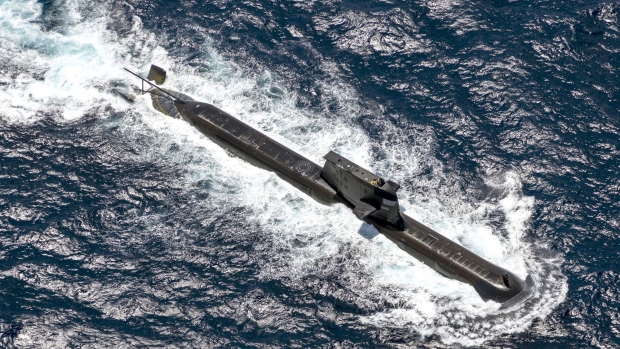Mar 8, 2023
Australia’s Nuclear-Powered Submarines Will Use a UK Design to Counter China
, Bloomberg News

(Bloomberg) -- Australia’s new fleet of nuclear-powered submarines will be based on a modified British design with US parts and upgrades, people familiar with the matter said, as the three countries press ahead with a security partnership meant to counter China.
The submarine plan, set to be announced next week, will take years to produce its first vessel, probably necessitating stopgap measures, according to the people, who asked not to be identified discussing private deliberations. In the meantime, the US may base nuclear submarines in Australia or even sell the country US Virginia-class submarines.
The decision on how to move ahead with the new subs will be unveiled on Monday in San Diego when President Joe Biden meets UK Prime Minister Rishi Sunak and Australian Prime Minister Anthony Albanese as part of their 18-month old Aukus partnership.
Spokespeople at the Pentagon and the National Security Council didn’t immediately respond to requests for comment.
Speaking in India on Thursday, Albanese confirmed the Monday Aukus meeting and said Australia would have the final say over all decisions involving its new fleet once it was ready, no matter the origin of the vessels.
“Australia will retain absolutely our sovereignty, our absolute sovereignty, 100%, it is very important,” he said.
China criticized the three nations over the sub plan, with Foreign Ministry spokeswoman Mao Ning saying Thursday at a regular press briefing in Beijing that they should “do more things that are conducive to regional peace and stability.”
Read more: US, France Dispute Australia Sub Deal Details as Ties Sour
The announcement marks a milestone in the 18-month-old agreement, which is intended to counter growing Chinese naval might in the Asia-Pacific region. The agreement, signed in September 2021, involves the three nations sharing classified military capabilities to allow Australia to construct and deploy nuclear-powered submarines.
Australia currently fields a fleet of six conventional Collins Class submarines, powered by diesel generators, which were commissioned between 1996 and 2003. Multiple Australian governments in the past decade have attempted to find an eventual replacement for the fleet, before settling on the plan to obtain nuclear submarines under the Aukus agreement.
“It makes sense to base or station some US submarines in Australia as a way to build the needed training and maintenance capacity in Australia,” said Bryan Clark, a former navy submariner who is now director of the Center for Defense Concepts and Technology at Hudson Institute. “The subs will be closer to the Western Pacific and Indian Ocean, which helps the US submarine presence there.”
The announcement of the pact in 2021 upset France, which saw its project to build non-nuclear submarines with Australia ditched as part of the new alliance.
How Aukus, Five Eyes and the Quad Evince China’s Rise: QuickTake
In a February speech, Albanese called the security arrangement the “biggest leap in our defense capability in our history.” He described the Australia-UK-US accord as the “future,” saying Australia has long known that “partnerships and alliances are key to our security.”
The agreement will give China several more stealthy submarines to worry about in any potential conflict over Taiwan, and the Chinese government has voiced strong opposition to the deal. Foreign Ministry spokeswoman Mao Ning said in February that it would fuel “military confrontation” in the region.
“By boosting capability and presence in the region, Aukus is intended to challenge Beijing’s local military superiority, create more operational challenges for the PRC, undercut its increasingly aggressive actions, and ultimately help stabilize the region,” said Charles Edel, Australia Chair at the Center for Strategic and International Studies, referring to the People’s Republic of China.
--With assistance from Ben Westcott and Colum Murphy.
(Updates with comment from China’s Foreign Ministry.)
©2023 Bloomberg L.P.